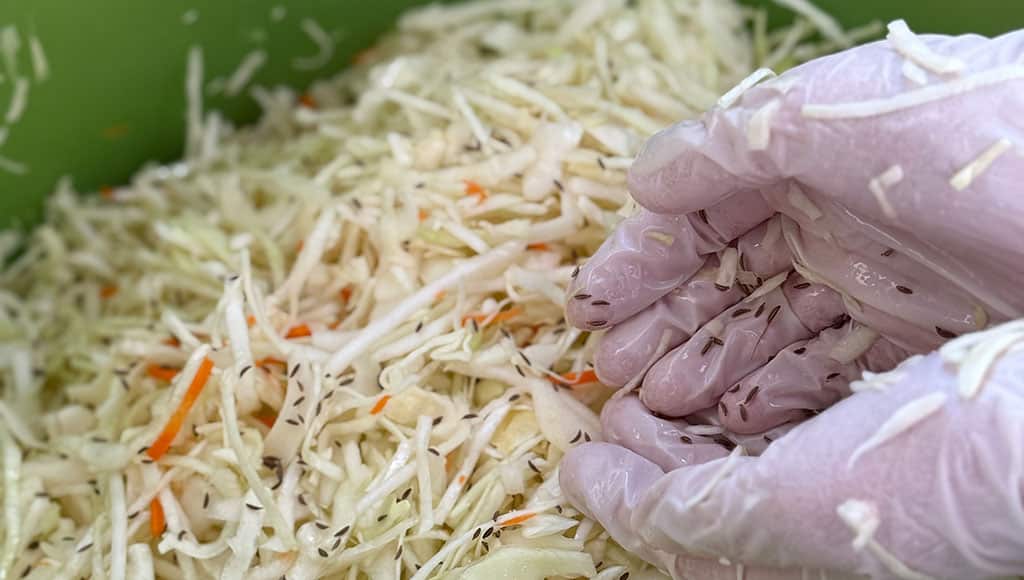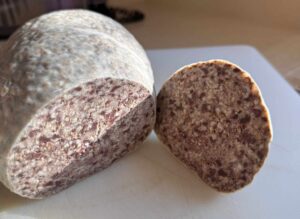Some foods are inherently (and, in my view, undeservedly) divisive. ‘Love it or hate it’ splits opinions on things like marmite, liquorice, coriander and sauerkraut. Whilst I am happy to acknowledge that, for some, certain flavours are inaccessible on genetic level, I do believe that, for most of us, accepting flavours is often a result of having a delicious tasting experience and that is for sure true and possible when the sauerkraut is done right!
Sauerkraut, meaning ‘Sour Cabbage’ in German, is most commonly associated with German and Eastern European cuisines. However, as one of many twists in gastronomic history, it might have actually originated in China.
According to some sources, during the construction of the Great Wall of China, men would be fed the diet of cabbage and rice in the summer, and in the winter, rice wine would be added to preserve the vegetables, causing them to ferment. Circa 13th century, the Mongol Horde introduced this type of fermented cabbage to Eastern Europeans who have later made it what it is now.
Lacking the rice wine, Eastern Europeans allowed the cabbage to acidify through the presence of salt and lacto-fermentation, the process when certain naturally occurring bacteria convert sugars present in fruit and vegetables into lactic acid. In other words, make them sour.
Here is how it happens …
It begins with shredded white or green cabbage that is introduced to 2%-2.5% salt. The cabbage and salt are mixed vigorously to break the cell walls and release juices. The mixture of the juice and salt creates the brine that facilitates fermentation and protects it at the same time.

During the first days of fermentation, Leuconostoc mesenteroides gets to work by kicking off acidification and by producing carbon dioxide that pushes out the oxygen, which is a precursor for bad bacteria to hustle their way in.
For this reason, it is important to put in that elbow grease into the mix so as to create enough brine to cover the cabbage. Choosing a narrow neck crock pot or jar might also help with that by reducing the surface area.
After 3-5 days, Lactobacillus plantarum takes over and its sole purpose is to create lactic acid. It does so leaving a great deal of flavour and texture subtleties in the final product at temperatures ranging between 18º-21ºC. For this reason, Portuguese winters are perfect for preparing sauerkraut. It is hard to keep within the recommended temperature parameters during the hot summers. As the last step of the process, L. brevis arrives and makes the sauerkraut a little effervescent, giving it a fizz.
It takes about a week for the sauerkraut to be ready, however, one can push fermentation further to develop a greater level of sourness. As soon as it is ready, the pot should be moved into a fridge to slow down fermentation that will continue even in the confines of the fridge. Typically, the best-by date for the sauerkraut is 1.5 months after the date of the cold confinement. The longer it is left, the more acidic and less crunchy it will become.
For its tangy, bright and sharp flavours, sauerkraut is a perfect counterpart to fatty and greasy foods. It is not surprising that it is a go-to partner to a bratwurst in a sandwich, a pork knuckle, or bangers and mash. It makes a delicious stuffing to Polish pierogi (dumplings) or yeast-based pies that my aunt has perfected for Christmas. Then there is the Russian sauerkraut soup called shchi and the Hungarian székely goulash, a sauerkraut stew.
The sauerkraut’s appeal goes beyond its delicious taste; it’s also a nutritional powerhouse. It is high in fibre, teaming with probiotics and rich in vitamin C, K and B6. Traditional Chinese have long prescribed sauerkraut juice as a home remedy for many common ailments, and in the late 1770s, Captain James Cook managed to successfully circumnavigate the world without losing a single sailor to scurvy, all thanks to the 60 barrels of sauerkraut on board of his vessel.
Interesting, as a divisive ingredient, cabbage is often associated with certain unpleasant smells. Well, here we must distinguish between two kinds. Firstly, there is dimethyl sulphide, the smell emitted by the freshly cooked cabbage. In low quantities, this chemical adds a much-welcomed complexity to red wine, but in higher doses, it can put off the eaters.
As luck would have it, dimethyl sulphide is almost completely absent in fully fermented sauerkraut, so make sure to keep yours for at least 3-4 weeks to avoid experiencing it if you are sensitive.
Secondly, there is what James Read calls in his book Of Cabbages & Kimchi the “post-prandial effluvium” caused by raffinose, a non-digestible sugar present in cabbage and beans. Our guts lack enzymes to break it down. However, as it turns out, raffinose is an in-built cabbage protection mechanism against frost. Hence, using James Read’s words again, summer cabbage sauerkraut “can fill your fridge without clearing the room”.
By Dr. Irina Mikhailava
|| features@algarveresident.com
Dr. Irina Mikhailava, a chef and a good food champion, happily residing in the Algarve and eating all over the world with an appetite for learning, sharing and writing. Instagram: incompanyoffood


























